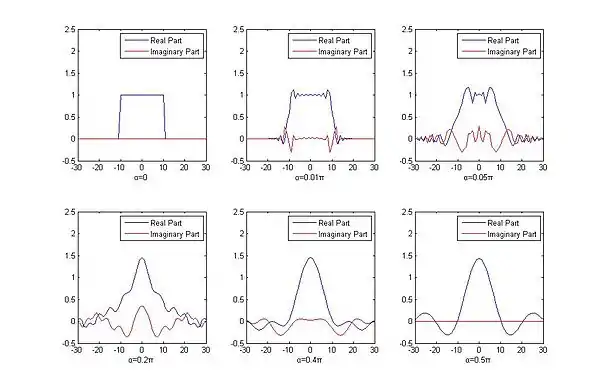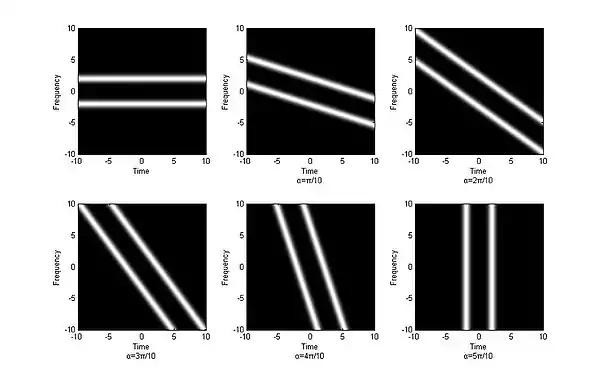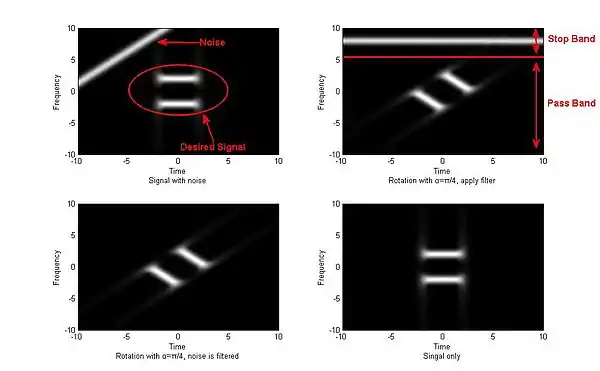Fractional Fourier transform
In mathematics, in the area of harmonic analysis, the fractional Fourier transform (FRFT) is a family of linear transformations generalizing the Fourier transform. It can be thought of as the Fourier transform to the n-th power, where n need not be an integer — thus, it can transform a function to any intermediate domain between time and frequency. Its applications range from filter design and signal analysis to phase retrieval and pattern recognition.
The FRFT can be used to define fractional convolution, correlation, and other operations, and can also be further generalized into the linear canonical transformation (LCT). An early definition of the FRFT was introduced by Condon,[1] by solving for the Green's function for phase-space rotations, and also by Namias,[2] generalizing work of Wiener[3] on Hermite polynomials.
However, it was not widely recognized in signal processing until it was independently reintroduced around 1993 by several groups.[4] Since then, there has been a surge of interest in extending Shannon's sampling theorem[5][6] for signals which are band-limited in the Fractional Fourier domain.
A completely different meaning for "fractional Fourier transform" was introduced by Bailey and Swartztrauber[7] as essentially another name for a z-transform, and in particular for the case that corresponds to a discrete Fourier transform shifted by a fractional amount in frequency space (multiplying the input by a linear chirp) and evaluating at a fractional set of frequency points (e.g. considering only a small portion of the spectrum). (Such transforms can be evaluated efficiently by Bluestein's FFT algorithm.) This terminology has fallen out of use in most of the technical literature, however, in preference to the FRFT. The remainder of this article describes the FRFT.
Introduction
The continuous Fourier transform of a function ƒ: R → C is a unitary operator of L2 that maps the function ƒ to its frequential version ƒ̂ (all expressions are taken in the L2 sense, rather than pointwise):
and ƒ is determined by ƒ̂ via the inverse transform
Let us study its n-th iterated defined by and when n is a non-negative integer, and . Their sequence is finite since is a 4-periodic automorphism: for every function ƒ, .
More precisely, let us introduce the parity operator that inverts , . Then the following properties hold:
The FRFT provides a family of linear transforms that further extends this definition to handle non-integer powers n = 2α/π of the FT.
Definition
Note: some authors write the transform in terms of the "order a" instead of the "angle α", in which case the α is usually a times π/2. Although these two forms are equivalent, one must be careful about which definition the author uses.
For any real α, the α-angle fractional Fourier transform of a function ƒ is denoted by and defined by
Formally, this formula is only valid when the input function is in a sufficiently nice space (such as L1 or Schwartz space), and is defined via a density argument, in a way similar to that of the ordinary Fourier transform (see article), in the general case.[8]
If α is an integer multiple of π, then the cotangent and cosecant functions above diverge. However, this can be handled by taking the limit, and leads to a Dirac delta function in the integrand. More directly, since must be simply f(t) or f(−t) for α an even or odd multiple of π respectively.
For α = π/2, this becomes precisely the definition of the continuous Fourier transform, and for α = −π/2 it is the definition of the inverse continuous Fourier transform.
The FrFT argument u is neither a spatial one x nor a frequency ξ. We will see why it can be interpreted as linear combination of both coordinates (x,ξ). When we want to distinguish the α-angular fractional domain, we will let denote the argument of .
Remark: with the angular frequency ω convention instead of the frequency one, the FrFT formula is the Mehler kernel,
Properties
The α-th order fractional Fourier transform operator, , has the properties:
- Additivity. For any real angles α, β,
- Linearity.
- Integer Orders. If α is an integer multiple of , then:
- Moreover, it has following relation
- Inverse.
- Commutativity.
- Associativity
- Unitarity
- Time Reversal.
- Transform of a shifted function
- Define the shift and the phase shift operators as follows:
- Then
- Transform of a scaled function
- Define the scaling and chirp multiplication operators as follows:
- Then,
- Notice that the fractional Fourier transform of cannot be expressed as a scaled version of . Rather, the fractional Fourier transform of turns out to be a scaled and chirp modulated version of where is a different order.
Fractional kernel
The FrFT is an integral transform
where the α-angle kernel is
Here again the special cases are consistent with the limit behavior when α approaches a multiple of π.
The FrFT has the same properties as its kernels :
- symmetry:
- inverse:
- additivity:
Related transforms
There also exist related fractional generalizations of similar transforms such as the discrete Fourier transform. The discrete fractional Fourier transform is defined by Zeev Zalevsky in (Candan, Kutay & Ozaktas 2000) and (Ozaktas, Zalevsky & Kutay 2001, Chapter 6). A quantum algorithm to implement a version of the discrete fractional Fourier transform in subpolynomial time is described by Somma.[9]
Fractional wavelet transform (FRWT):[10] A generalization of the classical wavelet transform (WT) in the fractional Fourier transform (FRFT) domains. The FRWT is proposed in order to rectify the limitations of the WT and the FRFT. This transform not only inherits the advantages of multiresolution analysis of the WT, but also has the capability of signal representations in the fractional domain which is similar to the FRFT. Compared with the existing FRWT, the FRWT (defined by Shi, Zhang, and Liu 2012) can offer signal representations in the time-fractional-frequency plane.
See also the chirplet transform for a related generalization of the Fourier transform.
Generalizations
The Fourier transform is essentially bosonic; it works because it is consistent with the superposition principle and related interference patterns. There is also a fermionic Fourier transform.[11] These have been generalized into a supersymmetric FRFT, and a supersymmetric Radon transform.[11] There is also a fractional Radon transform, a symplectic FRFT, and a symplectic wavelet transform.[12] Because quantum circuits are based on unitary operations, they are useful for computing integral transforms as the latter are unitary operators on a function space. A quantum circuit has been designed which implements the FRFT.[13]
Interpretation
The usual interpretation of the Fourier transform is as a transformation of a time domain signal into a frequency domain signal. On the other hand, the interpretation of the inverse Fourier transform is as a transformation of a frequency domain signal into a time domain signal. Fractional Fourier transforms transform a signal (either in the time domain or frequency domain) into the domain between time and frequency: it is a rotation in the time-frequency domain. This perspective is generalized by the linear canonical transformation, which generalizes the fractional Fourier transform and allows linear transforms of the time-frequency domain other than rotation.
Take the figure below as an example. If the signal in the time domain is rectangular (as below), it becomes a sinc function in the frequency domain. But if one applies the fractional Fourier transform to the rectangular signal, the transformation output will be in the domain between time and frequency.

The fractional Fourier transform is a rotation operation on a time-frequency distribution. From the definition above, for α = 0, there will be no change after applying the fractional Fourier transform, while for α = π/2, the fractional Fourier transform becomes a plain Fourier transform, which rotates the time-frequency distribution with π/2. For other value of α, the fractional Fourier transform rotates the time-frequency distribution according to α. The following figure shows the results of the fractional Fourier transform with different values of α.

Application
Fractional Fourier transform can be used in time frequency analysis and DSP.[14] It is useful to filter noise, but with the condition that it does not overlap with the desired signal in the time–frequency domain. Consider the following example. We cannot apply a filter directly to eliminate the noise, but with the help of the fractional Fourier transform, we can rotate the signal (including the desired signal and noise) first. We then apply a specific filter, which will allow only the desired signal to pass. Thus the noise will be removed completely. Then we use the fractional Fourier transform again to rotate the signal back and we can get the desired signal.

Thus, using just truncation in the time domain, or equivalently low-pass filters in the frequency domain, one can cut out any convex set in time–frequency space; just using time domain or frequency domain methods without fractional Fourier transforms only allow cutting out rectangles parallel to the axes.
Fractional Fourier transforms also have applications in quantum physics. For example, they are used to formulate entropic uncertainty relations.[15]
They are also useful in the design of optical systems and for optimizing holographic storage efficiency.[16]
See also
Other time-frequency transforms:
References
- E. U. Condon, "Immersion of the Fourier transform in a continuous group of functional transformations", Proc. Natl. Acad. Sci. USA 23, (1937) 158–164. online
- V. Namias, "The fractional order Fourier transform and its application to quantum mechanics," J. Inst. Appl. Math. 25, 241–265 (1980).
- N. Wiener, "Hermitian Polynomials and Fourier Analysis", J. Mathematics and Physics 8 (1929) 70-73.
- Luís B. Almeida, "The fractional Fourier transform and time-frequency representations," IEEE Trans. Signal Process. 42 (11), 3084–3091 (1994).
- Ran Tao, Bing Deng, Wei-Qiang Zhang and Yue Wang, "Sampling and sampling rate conversion of band limited signals in the fractional Fourier transform domain," IEEE Transactions on Signal Processing, 56 (1), 158–171 (2008).
- A. Bhandari and P. Marziliano, "Sampling and reconstruction of sparse signals in fractional Fourier domain," IEEE Signal Processing Letters, 17 (3), 221–224 (2010).
- D. H. Bailey and P. N. Swarztrauber, "The fractional Fourier transform and applications," SIAM Review 33, 389-404 (1991). (Note that this article refers to the chirp-z transform variant, not the FRFT.)
- "Archived copy" (PDF). Archived from the original (PDF) on 2018-11-03. Retrieved 2018-11-03.CS1 maint: archived copy as title (link)
- Rolando D. Somma, "Quantum simulations of one dimensional quantum systems," Quantum Information and Computation, Vol. 16, No. 13&14, pp. 1125–1168, 2016. URL: http://www.rintonpress.com/xxqic16/qic-16-1314/1125-1168.pdf
- J. Shi, N.-T. Zhang, and X.-P. Liu, "A novel fractional wavelet transform and its applications," Sci. China Inf. Sci. vol. 55, no. 6, pp. 1270-1279, June 2012. doi:10.1007/s11432-011-4320-x
- Hendrik De Bie, Fourier transform and related integral transforms in superspace (2008), http://www.arxiv.org/abs/0805.1918
- Hong-yi Fan and Li-yun Hu, Optical transformation from chirplet to fractional Fourier transformation kernel (2009), http://www.arxiv.org/abs/0902.1800
- Andreas Klappenecker and Martin Roetteler, Engineering Functional Quantum Algorithms (2002), http://www.arxiv.org/abs/quant-ph/0208130
- E. Sejdić, I. Djurović, LJ. Stanković, “Fractional Fourier transform as a signal processing tool: An overview of recent developments”, Signal Processing, vol. 91, no. 6, pp. 1351–1369, June 2011. doi:10.1016/j.sigpro.2010.10.008.
- Huang, Yichen (24 May 2011). "Entropic uncertainty relations in multidimensional position and momentum spaces". Physical Review A. 83 (5): 052124. arXiv:1101.2944. doi:10.1103/PhysRevA.83.052124. S2CID 119243096.
- N. C. Pégard and J. W. Fleischer, "Optimizing holographic data storage using a fractional Fourier transform", Opt. Lett. 36, 2551–2553 (2011) .
External links
- DiscreteTFDs -- software for computing the fractional Fourier transform and time-frequency distributions
- "Fractional Fourier Transform" by Enrique Zeleny, The Wolfram Demonstrations Project.
- Dr YangQuan Chen's FRFT (Fractional Fourier Transform) Webpages
- LTFAT - A free (GPL) Matlab / Octave toolbox Contains several version of the fractional Fourier transform.
Bibliography
- Ozaktas, Haldun M.; Zalevsky, Zeev; Kutay, M. Alper (2001), The Fractional Fourier Transform with Applications in Optics and Signal Processing, Series in Pure and Applied Optics, John Wiley & Sons, ISBN 978-0-471-96346-2
- Candan, C.; Kutay, M.A.; Ozaktas, H.M. (May 2000), "The discrete fractional Fourier transform" (PDF), IEEE Transactions on Signal Processing, 48 (5): 1329–1337, doi:10.1109/78.839980, hdl:11693/11130
- A. W. Lohmann, "Image rotation, Wigner rotation and the fractional Fourier transform," J. Opt. Soc. Am. A 10, 2181–2186 (1993).
- Soo-Chang Pei and Jian-Jiun Ding, "Relations between fractional operations and time-frequency distributions, and their applications," IEEE Trans. Signal Process. 49 (8), 1638–1655 (2001).
- Jian-Jiun Ding, Time frequency analysis and wavelet transform class notes, the Department of Electrical Engineering, National Taiwan University (NTU), Taipei, Taiwan, 2007.
- Saxena, R., Singh, K., (2005) Fractional Fourier transform: A novel tool for signal processing, J. Indian Inst. Sci., Jan.–Feb. 2005, 85, 11–26. https://web.archive.org/web/20110716112239/http://journal.library.iisc.ernet.in/vol200501/paper2/11.pdf.
